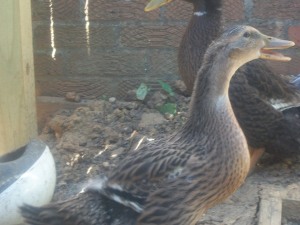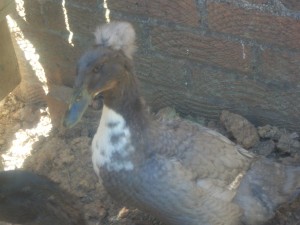The ducks we incubated were seven weeks old yesterday, and I’ve finally determined what kind of ducks they are! I didn’t have photos for a while so I wasn’t able to ‘introduce’ our ducks to you. Now I have pictures, though since they were in an unplanted raised garden bed when I took the picture, it’s not a very nice background.
I’d been scouring the internet for pictures, and tentatively decided on two breeds. I finally decided to stop being wimpy and contacted the person who I got the eggs we incubated from – she has an inadvertent way of making people feel foolish for not knowing the answers to their questions, and I didn’t really feel like going through that after experiencing it twice. The eggs were from a farm of a friend of hers, so I got the name of the farm, googled it, and got a phone number.
What a pleasure! Seven weeks of wondering what kind of ducks they were, and it took one minute to resolve! All I needed to know was what breeds she raised – she named four breeds, and two of them were what I thought our ducks were! That was gratifying. 🙂

Peeps was the cutest of the three ducks that we incubated – she was yellow with some black striping when she hatched. As she’s gotten older, she’s gotten darker and darker. Even though she’s reaching a mature size, the kids still like her best. They think she’s the friendliest and the prettiest. Dd9 cuddles her against her chest and shoulder like a baby. 🙂

Darth as a newly hatched chick was very dark brown, so the kids named him Darth Vader. We thought he was a she until a week or two ago, when ds11 noticed the feathers on top of his head were getting darker. And then I realized his beak color had changed as well, and then noticed his feet were a different color than the others. He is a male Rouen duck.

Mo is a crested Swedish Blue – the crest is the cute little puff of fluff on top of her head. Any kind of duck can be crested, thought it’s not extremely common. Mo was the first duckling to hatch; it took two days for her to break through her shell after she pipped and I didn’t think she’d make it. In the beginning she was the strongest and biggest but with time she’s lost that advantage. She was dark grey when she was born, and got lighter and lighter as she got older; we thought she was a he until recently. Now she’s a light gray. Mo is short for Mohawk. I couldn’t figure out what kind of duck she was for a while because this wasn’t one of the breeds on my radar – the idea suddenly came to me out of the blue and so I looked up pictures of Swedish Blues and sure enough, she was a match!
It’s been so interesting to watch them grow and develop. It’s been a great learning experience for us. Identifying them was most challenging ‘lesson’ because the baby pictures I found online didn’t match up with our ducks. As ducklings, I never thought that Peeps and Darth were from the same breed, since their coloring was very different at that age. I actually thought the two dark ducklings were the same kind of duck, and then as they got older realized they weren’t a bit alike.
A couple of people have contacted me, interested in purchasing these ducks. I was planning to give them to the people where I buy my duck eggs from, but if I find a good home closer and sooner, I’ll do that instead. Since I have limited space and the ducklings will be getting big soon, I can’t have all of them free ranging at the same time. (Right now the ducklings are outside in a caged area that is open at the bottom so they can forage and are still protected from predators, but in about a week or two they’ll be big enough to be out during the day.) So my preference is to find a new home for these lovely ducks right away.

Here are the newest ducklings. They are two weeks old as of yesterday. These are all Welsh Harlequins, and we haven’t been able to name most of them since they all look so similar! The exceptions are Sunny, the duck in the foreground on the right whose beak is lighter than the others, and Indy, who had an eye injury last week. Sunny is the lightest of all of them, hence her name.
Indy is short for Endurance, since even when it looked like she had lost all sight in one eye, she kept struggling on. Walking was challenging for her because she lost her sense of balance, and she was falling into the water dish since she couldn’t see anything from one side of her head when she walked. The first morning after she got hurt when we saw her, she wasn’t eating or drinking and was mostly standing in one place or apart from the others, getting pecked by them. It was painful to see and I was really concerned; I spent hours that day watching her to see how she was doing.
BH Indy’s eye has almost completely healed and her eyesight is back to normal. A few days ago one side of her face looked deformed due to the swelling, now you can hardly tell the difference between her and the others. I didn’t expect it her eyesight to be restored or for her to look normal again, and I’m so, so glad for her that she’ll be able to grow up healthy in every way. We had already decided after she got hurt that she would be one of the four ducks we would keep, to be sure she’d have a good home.
Usually you can’t tell at a young age if a duckling is male or female, unless you are very experienced with what’s called vent sexing, but something unique about Welsh Harlequins is that the females are born with pink bills and the males with dark bills. This changes within a few days and then they’re all dark; to make it more confusing, as they get older, the males bills get lighter! Since the ducklings were sent when they were a day old, and we got them two days later, I wasn’t sure if the bill color would still be accurate at three days old, so I asked the hatchery to mark those they thought were female. (They did, but warned me that the bill color isn’t 100% accurate.) In the end, it took probably a week before their bills changed and what I noted matched how they marked the ducklings – now Sunny is the only one with any pink on her bill.
I’m planning to sell four of the Welsh Harlequin ducklings, and the only question I’m going back and forth in my mind about is whether to keep four females or three females and a male. The advantage of more females is more eggs (eventually); the advantage of a male is that they can reproduce if we for whatever reason would want that. At this point we’re leaning toward three females and a male.
Avivah
Are you sure about not keeping the Sweedish Blue? What in interesting duck!
Hi Avivah– I have been silently following the yard, garden, and duckling developments. What a great idea for healthy outdoor activities in the spring and summer. The photos are definitely appreciated! Very cute ducklings. I am still trying to figure out how they mailed them to you though?!! Can you please elaborate on that for me? Also, any suggestions for budding young gardeners who live in an apartment? Thanks!
Hi, Rivka!
I took a picture of the box they were sent in when we got them, meaning to post it, but then the batteries on the camera died. Anyway, they were sent in a box with straw on the bottom inside and air holes on the side. They don’t need to eat for a few days after being born, so they don’t need food.
They usually pack ten ducklings to ensure that they all stay warm (because it’s so hot now, they agreed to send just 8 and I paid a little extra for them to adjust the shipping box.) We gave them food and water immediately after picking them up.
What a great story and I never knew they didn’t need to eat for the first few days.
I just took pictures of ducks on Lake Ontario today. They must be hardy to be in that cold water!
http://photoserendipity.wordpress.com/2010/12/29/ducks-riding-the-waves/
Hi, workingtechmom, welcome! Thanks for sharing the picture of the ducks!